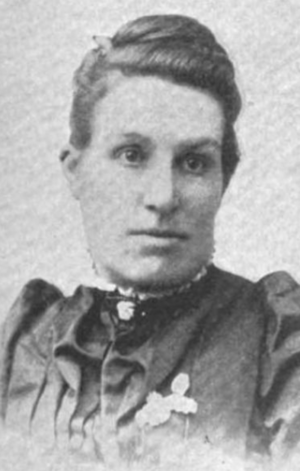Mary G. Charlton Edholm facts for kids
Quick facts for kids
Mary G. Charlton Edholm
|
|
|---|---|

Mary G. Charlton Edholm, from an 1895 publication
|
|
| Born | Mary Grace Charlton October 28, 1854 Freeport, Illinois, U.S. |
| Died | November 29, 1935 (aged 81) |
| Occupation | reformer, journalist |
| Language | English |
| Nationality | American |
| Alma mater | Monmouth College |
| Literary movement | temperance |
| Notable works | The Traffic in Girls and Florence Crittenton Missions |
| Spouse |
Osborn L. Edholm
(m. 1878) |
Mary G. Charlton Edholm (October 28, 1854 – November 29, 1935) was an American woman who worked as a reformer and journalist. She spent twenty years working as a journalist. In 1891, Edholm was chosen to lead the press work for the Woman's Christian Temperance Union (WCTU) at their meeting in Boston.
Much of her work focused on Christian values, the temperance movement (which aimed to reduce alcohol use), and helping others. For many years, she wrote about 250 articles each year. These articles explained the work of the WCTU to thousands of newspapers around the world.
While helping to edit a booklet for an evangelist named Charles Nelson Crittenton, she became interested in helping girls who were being exploited. This led her to write her book, The Traffic in Girls and Florence Crittenton Missions. Edholm cared so much about these girls that she decided to make helping them her main focus. She continued to speak and write to support them. In 1886, Edholm moved to Oakland, California. By 1893, she was living in Chicago with her only son.
Early Life and Education
Mary Grace Charlton was born in Freeport, Illinois, on October 28, 1854. Her talent for journalism came from her parents, James B. Charlton and Lucy Gow Charlton. Both of her parents were good writers who supported important causes. They worked for the abolition of slavery, the temperance movement, and women's suffrage (the right for women to vote).
Mary went to public schools and then to college for two years. During her second year at Monmouth College, she wrote an essay titled "Shall our Women Vote?" She sent it to the Woman's Journal in Boston, and it was published.
Journalism and Reform Work
After college, Mary wrote articles about women's suffrage and the temperance movement for different magazines and newspapers.
In 1878, she married Osborn L. Edholm, who was also a journalist. She loved writing and reporting even more after they married. For several years, they traveled a lot together. This travel helped her gain knowledge and information that she used in her writing. During these years, her articles appeared in major newspapers like the New York World and the Chicago Tribune. She wrote continuously, both before and after her children were born.
In 1886, Edholm moved to Oakland, California. She was chosen to be the official reporter for the WCTU. In 1891, she became the superintendent of their press work. Each year, she wrote about 250 articles about temperance for over 200 newspapers. These included daily papers in San Francisco, Oakland, Portland, New Orleans, Boston, and New York City. She also wrote for The Union Signal. She even led three WCTU trips across the United States. Important leaders like Frances Willard helped her get promoted.
Edholm also served as a secretary for the International Federation Women's Press League. She was the editor of The Christian Home newspaper in Oakland.
For many years, Edholm was very interested in helping girls who were being exploited. She wrote many articles defending women in newspapers like the Woman's Journal and The Woman's Tribune. Her articles described the terrible conditions of girls being forced into difficult situations. In Oakland, she met Charles Nelson Crittenton, who had started the National Florence Crittenton Missions to help these girls. Edholm became so enthusiastic about describing the work of the Florence Missions that Crittenton made her a reporter for them. This allowed her to help even more women through her journalism. In 1895, Edholm was named superintendent of the Crittenton Missions. She wrote about the challenges these girls faced and how the Florence Missions helped them in her book, The Traffic in Girls and Florence Crittenton Missions. She also put together a book about the life of Emily Pitt Stevens, another important WCTU leader.
In 1901, Edholm started the Lucy Charlton Memorial, named after her mother. This was a home in Oakland for women and children who needed help. She used her own home for this purpose and supported the charity with money from her lectures and book sales. In 1902, she was nominated by the Prohibition Party to be the State Superintendent of Public Instruction in California.
Later Life
Mary G. Charlton Edholm lived in Oakland for many years and was active in her church there. She passed away on November 29, 1935, in Dobbs Ferry, New York.

